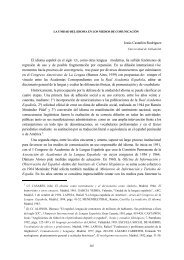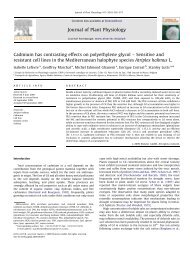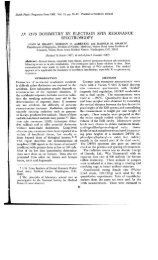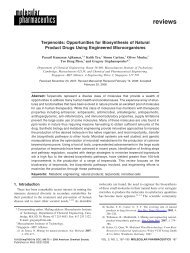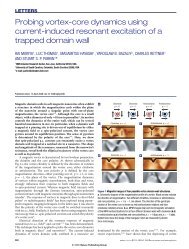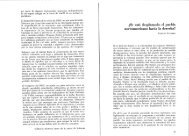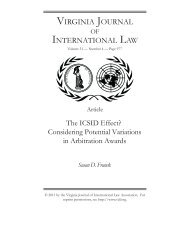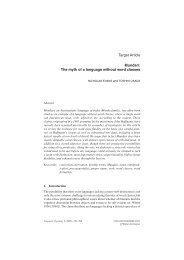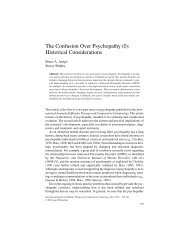Volatile composition of oak and chestnut woods used in brandy ...
Volatile composition of oak and chestnut woods used in brandy ...
Volatile composition of oak and chestnut woods used in brandy ...
You also want an ePaper? Increase the reach of your titles
YUMPU automatically turns print PDFs into web optimized ePapers that Google loves.
Abstract<br />
<strong>Volatile</strong> <strong>composition</strong> <strong>of</strong> <strong>oak</strong> <strong>and</strong> <strong>chestnut</strong> <strong>woods</strong> <strong>used</strong> <strong>in</strong><br />
br<strong>and</strong>y age<strong>in</strong>g: Modification <strong>in</strong>duced by heat treatment<br />
Ilda Caldeira a, *, M.C. Clímaco a , R. Bruno de Sousa b , A.P. Belchior a<br />
a INIAP-Estação Vitiv<strong>in</strong>ícola Nacional, 2565-191 Dois Portos, Portugal<br />
b Instituto Superior de Agronomia, Departamento de Química Agrícola e Ambiental, Tapada da Ajuda, 1349-017 Lisboa, Portugal<br />
Received 11 December 2004; accepted 10 May 2005<br />
Available onl<strong>in</strong>e 5 July 2005<br />
The volatile <strong>composition</strong> (26 compounds) <strong>of</strong> seven different types <strong>of</strong> wood (6 <strong>oak</strong>s <strong>and</strong> 1 <strong>chestnut</strong>), <strong>used</strong> <strong>in</strong> br<strong>and</strong>y age<strong>in</strong>g, were<br />
studied by GC–MS <strong>and</strong> the modification <strong>in</strong>duced by the heat treatment, that occurs dur<strong>in</strong>g the barrel mak<strong>in</strong>g, was evaluated. Some<br />
<strong>of</strong> these compounds are identified for the first time, namely the 4-hydroxy-2-butenoic acid lactone <strong>in</strong> <strong>oak</strong> <strong>and</strong> <strong>chestnut</strong> wood, <strong>and</strong><br />
2 + 3-methyl-1-butanol, benzaldehyde, acetovanillone, b-methyl-c-octalactone, guaiacol, 4-methylguaiacol, 4-propylguaiacol,<br />
4-ethylguaiacol, eugenol, isoeugenol, 4-methylsyr<strong>in</strong>gol <strong>and</strong> 4-allyl-syr<strong>in</strong>gol <strong>in</strong> <strong>chestnut</strong>. Eugenol, cis-b-methyl-c–octalactone, furfural,<br />
4-hydroxy-2-butenoic acid lactone, hexanoic acid <strong>and</strong> guaiacol seemed to be important compounds, which could help to control<br />
the wood orig<strong>in</strong>. The toast<strong>in</strong>g process modified strongly the volatile <strong>composition</strong> <strong>of</strong> the different types <strong>of</strong> wood, particularly the<br />
levels <strong>of</strong> furanic aldehydes (furfural, 5-methylfurfural, HMF), volatile phenols (syr<strong>in</strong>gol <strong>and</strong> 4-allyl-syr<strong>in</strong>gol), propanoic acid,<br />
4-hydroxy-2-butenoic acid lactone <strong>and</strong> vanill<strong>in</strong>.<br />
Ó 2005 Elsevier Ltd. All rights reserved.<br />
Keywords: <strong>Volatile</strong>s; Oak; Chestnut; Toast<strong>in</strong>g<br />
1. Introduction<br />
Journal <strong>of</strong> Food Eng<strong>in</strong>eer<strong>in</strong>g 76 (2006) 202–211<br />
The age<strong>in</strong>g <strong>of</strong> br<strong>and</strong>y <strong>and</strong> other alcoholic beverages is<br />
usually performed by its storage <strong>in</strong> <strong>oak</strong> barrels for many<br />
years. Dur<strong>in</strong>g this maturation period, also known as<br />
barrel-age<strong>in</strong>g, the beverage acquires <strong>in</strong>terest<strong>in</strong>g sensorial<br />
characteristics, as a result <strong>of</strong> extraction <strong>and</strong> the degradation<br />
<strong>of</strong> many compounds from the woodÕs matrix. Historically<br />
several types <strong>of</strong> wood have been <strong>used</strong>, but the<br />
most commonly <strong>used</strong> wood, which is also the most studied,<br />
is <strong>oak</strong> wood, namely some European species<br />
(Quercus robur <strong>and</strong> Quercus sessiliflora) <strong>and</strong> white <strong>oak</strong><br />
from America (Quercus alba).<br />
*<br />
Correspond<strong>in</strong>g<br />
261712426.<br />
author. Tel.: +351 261712106; fax: +351<br />
E-mail addresses: <strong>in</strong>ia.evn.tec@on<strong>in</strong>et.pt, <strong>in</strong>ia.evn.quim@on<strong>in</strong>et.pt<br />
(I. Caldeira).<br />
0260-8774/$ - see front matter Ó 2005 Elsevier Ltd. All rights reserved.<br />
doi:10.1016/j.jfoodeng.2005.05.008<br />
www.elsevier.com/locate/jfoodeng<br />
The process <strong>of</strong> barrel mak<strong>in</strong>g, known as cooperage,<br />
consists <strong>of</strong> several steps, <strong>in</strong>clud<strong>in</strong>g preparation <strong>of</strong> stave<br />
wood, dry<strong>in</strong>g <strong>and</strong> season<strong>in</strong>g <strong>of</strong> the wood, ‘‘rais<strong>in</strong>g’’ the<br />
barrel, bend<strong>in</strong>g under heat <strong>and</strong> toast<strong>in</strong>g, bevell<strong>in</strong>g,<br />
groov<strong>in</strong>g <strong>and</strong> plac<strong>in</strong>g heads, hoop<strong>in</strong>g <strong>and</strong> check<strong>in</strong>g<br />
(Puech & Moutounet, 1993).<br />
The volatile compounds extracted from the wood<br />
dur<strong>in</strong>g barrel-age<strong>in</strong>g are very important, because they<br />
are related to some flavour properties <strong>of</strong> alcoholic beverage.<br />
The accumulation <strong>of</strong> volatile <strong>oak</strong> compounds <strong>in</strong><br />
br<strong>and</strong>y dur<strong>in</strong>g the maturation period depends on many<br />
factors, particularly the quantity <strong>of</strong> volatile compounds<br />
available <strong>and</strong> their precursors presented <strong>in</strong> the woodÕs<br />
matrix. The amount <strong>of</strong> volatile <strong>oak</strong> compounds depend<br />
on several factors, such as geographical orig<strong>in</strong>, the species<br />
<strong>of</strong> <strong>oak</strong> (Canas, Le<strong>and</strong>ro, Spranger, & Belchior,<br />
2000; Chatonnet & Dubourdieu, 1998; Marco,<br />
Artajona, Larrechi, & Rius, 1994; Masson, Guichard,
Fournier, & Puech, 1995; Miller, Howell, Michaelis, &<br />
Dickman, 1992; Mosedale & Savill, 1996; Nabeta,<br />
Yonekubo, & MiYake, 1986; Sefton, Francis, Pocock,<br />
& Williams, 1993), the season<strong>in</strong>g <strong>of</strong> the staves (Chatonnet,<br />
1995; Sefton et al., 1993) <strong>and</strong> the toast<strong>in</strong>g <strong>of</strong> the<br />
barrel (Artajona, 1991; Canas, 2003; Chatonnet, 1995;<br />
Chatonnet, Boidron, & Pons, 1989; Dubois, 1989;<br />
Maga, 1985; Nishimura, Onishi, Masuda, Koga, &<br />
Matsuyama, 1983; Nomdedeu et al., 1988; Sarni, Moutounet,<br />
Puech, & Rabier, 1990).<br />
In spite <strong>of</strong> a substantial knowledge about volatile<br />
<strong>composition</strong> <strong>of</strong> French <strong>and</strong> American <strong>oak</strong> wood, few<br />
data are available for others <strong>woods</strong>, namely <strong>chestnut</strong><br />
<strong>and</strong> <strong>oak</strong> Portuguese <strong>woods</strong> (Borralho, 1994; Clímaco &<br />
Borralho, 1996) <strong>and</strong> from a cooperage po<strong>in</strong>t <strong>of</strong> view<br />
the first <strong>chestnut</strong> wood results were presented <strong>in</strong> preced<strong>in</strong>g<br />
works (Canas, Le<strong>and</strong>ro, Spranger, & Belchior, 1998,<br />
1999). In our previous work, it was found that the br<strong>and</strong>ies<br />
aged from <strong>chestnut</strong> barrels presented a good quality<br />
(Belchior et al., 1998; Caldeira et al., 1998) <strong>and</strong> higher<br />
levels <strong>of</strong> some phenolic compounds (Canas, Caldeira,<br />
et al., 1998; Canas, Le<strong>and</strong>ro, Spranger, & Belchior,<br />
1999).<br />
The aim <strong>of</strong> this study is to characterise Portuguese<br />
<strong>chestnut</strong> <strong>and</strong> <strong>oak</strong> wood comparatively with French<br />
<strong>and</strong> American <strong>oak</strong> wood, us<strong>in</strong>g volatile <strong>composition</strong><br />
<strong>and</strong> also to po<strong>in</strong>t out the modifications <strong>in</strong>duced by the<br />
heat treatment, made dur<strong>in</strong>g the cooperage process.<br />
2. Material <strong>and</strong> methods<br />
2.1. Experimental design <strong>and</strong> wood sampl<strong>in</strong>g<br />
A two factorial design (7 <strong>woods</strong> · 4 toast<strong>in</strong>g levels · 2<br />
replicates) was established <strong>and</strong> 56 wood samples were<br />
taken.<br />
The anatomical study (Carvalho, 1998) led to the<br />
botanical identification <strong>of</strong> seven wood species: three<br />
Portuguese <strong>oak</strong> wood, which were all Quercus pyrenaica<br />
Willd. from three different sites <strong>in</strong> the north <strong>of</strong> Portugal<br />
(CNE, CNF, CNG); two French <strong>oak</strong> wood, one from<br />
Allier identified as Quercus sessiliflora Sallisb. (CFA)<br />
<strong>and</strong> another from Limous<strong>in</strong> region identified as Quercus<br />
robur L. (CFL); one American <strong>oak</strong> wood which was a<br />
mixture <strong>of</strong> Quercus alba L./Quercus stellata Wangenh.<br />
<strong>and</strong> Quercus lyrata Walt./Quercus bicolor Willd.(CAM)<br />
<strong>and</strong> one Portuguese <strong>chestnut</strong> wood (CAST), from the<br />
northern, identified as Castanea sativa Mill. From each<br />
wood, six barrels were constructed, which were submitted<br />
to heat treatment with 3 degrees <strong>of</strong> toast<strong>in</strong>g: light<br />
(QL), medium (QM) <strong>and</strong> strong (QF), with two replicates<br />
<strong>of</strong> each. Before <strong>and</strong> after the toast<strong>in</strong>g process <strong>of</strong><br />
the barrels, shaves were cut <strong>in</strong> order to get samples from<br />
the wood. The two replicates <strong>of</strong> each wood, taken before<br />
toast<strong>in</strong>g, represent the fist level <strong>of</strong> toast<strong>in</strong>g factor (Q0).<br />
I. Caldeira et al. / Journal <strong>of</strong> Food Eng<strong>in</strong>eer<strong>in</strong>g 76 (2006) 202–211 203<br />
The toast<strong>in</strong>g process was controlled by the cooper 1 ,<br />
which is about 10 m<strong>in</strong> (light toast<strong>in</strong>g), 20 m<strong>in</strong> (medium<br />
toast<strong>in</strong>g) <strong>and</strong> 25 m<strong>in</strong> (strong toast<strong>in</strong>g) <strong>of</strong> slow toast<strong>in</strong>g<br />
the barrel, over a fire <strong>of</strong> the respective wood <strong>of</strong>fcuts.<br />
2.2. Wood extraction<br />
Hydroalcoholic wood extracts were obta<strong>in</strong>ed with<br />
50 g <strong>of</strong> milled wood (Hammer-Mill–Wiley) macerated,<br />
under rotary agitation for 180 m<strong>in</strong> at 20 °C, with<br />
1000 mL <strong>of</strong> an ethanol–water solution at 55% v/v adjusted<br />
to pH 4.2 with hydrochloric acid, accord<strong>in</strong>g to<br />
conditions previously selected (Caldeira, Pereira,<br />
Clímaco, Belchior, & Bruno de Sousa, 2004).<br />
The hydroalcoholic wood extracts were filtered<br />
through a glass micr<strong>of</strong>ibre filter (Whatman GF/C) <strong>in</strong> a<br />
Büchner funnel.<br />
2.3. Wood moisture<br />
The wood powder moisture was determ<strong>in</strong>ed <strong>in</strong> a<br />
moisture analyser (Mettler LJ 16-Switzerl<strong>and</strong>).<br />
2.4. Analysis <strong>of</strong> volatile compounds<br />
The isolation <strong>of</strong> the volatile compounds, from the<br />
hydroalcoolic wood extracts, was done by liquid/liquid<br />
extraction with three successive aliquots <strong>of</strong> dichloromethane,<br />
<strong>and</strong> the analysis <strong>of</strong> the compounds by GC<br />
<strong>and</strong> GC–MS, was carried out as described by Caldeira<br />
(2004) <strong>and</strong> Caldeira et al. (2004), with some modifications<br />
on the GC conditions: each concentrated extract<br />
was <strong>in</strong>jected <strong>in</strong> a Carlo Erba 6000 Vega series equipped<br />
with a flame ionisation detector (250 °C) <strong>and</strong> with a silica<br />
capillary column (DB-WAX–J&W: 30 m-lengh,<br />
0.32 mm-<strong>in</strong>ternal diameter, 0.25 lm-film thickness); elution<br />
was carried out with hydrogen as carrier gas<br />
(1.4 mL m<strong>in</strong> 1 ); temperature program: 3.5 °C m<strong>in</strong> 1<br />
from 45 °C (5-m<strong>in</strong> isothermal) to 210 °C (30-m<strong>in</strong> isothermal);<br />
the <strong>in</strong>jector was at 250 °C, <strong>and</strong> approximately<br />
0.8 lL was <strong>in</strong>jected with a split ratio <strong>of</strong> 1:15.<br />
Quantification was carried out by the <strong>in</strong>ternal st<strong>and</strong>ard<br />
method; the response factor <strong>of</strong> volatile compounds<br />
to the <strong>in</strong>ternal st<strong>and</strong>ard was arbitrarily fixed at 1.0 <strong>and</strong><br />
the results were expressed as lg/g <strong>of</strong> dry wood.<br />
2.4.1. Reagents<br />
All solvents <strong>used</strong> were analytical grade purchased<br />
from Merck (Darmstadt, Germany) <strong>and</strong> the dichloromethane<br />
were bidistilled.<br />
2.4.2. Reference compounds<br />
Acetic acid was purchased from Riedel-de-Haen (Seelze,<br />
Germany); 2-methyl-1-butanol, 3-methyl-1-butanol,<br />
1 Tanoaria J. M. Gonçaves, Palaçoulo-Portugal.
204 I. Caldeira et al. / Journal <strong>of</strong> Food Eng<strong>in</strong>eer<strong>in</strong>g 76 (2006) 202–211<br />
2-octanol, furfural, benzaldehyde, propanoic acid, 5methyl-furfural,<br />
4-hydroxy-2-butenoic acid lactone,<br />
hexanoic acid, guaiacol, 2-phenylethanol, octanoic<br />
acid, eugenol, 3,4-dimethylphenol, syr<strong>in</strong>gol, decanoic<br />
acid, dodecanoic acid, 5-hydroxymethyl-2-furaldehyde<br />
(HMF), 4-hydroxy-3-methoxy-benzaldehyde (vanill<strong>in</strong>)<br />
were purchased from Fluka (Buchs, Switzerl<strong>and</strong>);<br />
cis,trans-b-methyl-c-octalactone, 4-propyl-guaiacol, isoeugenol,<br />
4-methyl-syr<strong>in</strong>gol, 4-allyl-syr<strong>in</strong>gol, acetovanillone<br />
were purchased from Aldrich (Ste<strong>in</strong>heim,<br />
Germany); 4-methyl-guaiacol, 4-ethylguaiacol were purchased<br />
from TCI. All <strong>of</strong> them were <strong>used</strong> as st<strong>and</strong>ards<br />
without further purification. Solutions were prepared<br />
with ethanol/water (20:80 v/v).<br />
2.5. Statistical analysis<br />
Analysis <strong>of</strong> variance (ANOVA). The results <strong>of</strong> the<br />
volatile compounds analysed from the 56 wood samples<br />
were submitted to a two-way analysis <strong>of</strong> variance,<br />
with wood orig<strong>in</strong> (7 levels: CNE, CNF, CNG, CAST,<br />
CFA, CFL, CAM) <strong>and</strong> toast<strong>in</strong>g <strong>in</strong>tensity (4 levels: without<br />
toast<strong>in</strong>g, Q0; light toast<strong>in</strong>g, QL; medium toast<strong>in</strong>g,<br />
QM; strong toast<strong>in</strong>g, QF) as permanent factors. Calculation<br />
<strong>of</strong> the least significant difference (LSD) was applied,<br />
for comparison <strong>of</strong> the different averages, <strong>of</strong> the<br />
volatile compounds (Montgomery, 1991). All the calculations<br />
were performed us<strong>in</strong>g Statgraphics-statistical<br />
system/ vs 5.0.<br />
Multivariate analysis. The results were also subjected<br />
to the multivariate analysis (cluster<strong>in</strong>g, pr<strong>in</strong>cipal component<br />
analysis). All the calculations were carried out<br />
1<br />
i.s.1<br />
2<br />
3<br />
4<br />
5<br />
6<br />
7<br />
8 9<br />
10<br />
11<br />
12+13<br />
us<strong>in</strong>g NTSYS-pc package, version 1.7 (Rohlf, 1993)<br />
<strong>and</strong> the StatisticaÕ98 edition.<br />
3. Results <strong>and</strong> discussion<br />
3.1. <strong>Volatile</strong> compounds identified<br />
Among the several chromatographic peaks present <strong>in</strong><br />
the <strong>oak</strong> extracts, 26 compounds were identified (Fig. 1).<br />
Many <strong>of</strong> the volatile compounds identified by GC <strong>and</strong><br />
GC–MS analysis on the aqueous alcoholic wood dichloromethane<br />
extracts are recognised as be<strong>in</strong>g present <strong>in</strong><br />
untreated <strong>oak</strong> extracts <strong>and</strong> <strong>in</strong> heated <strong>oak</strong> extracts by<br />
various authors (Artajona, 1991; Chatonnet et al.,<br />
1989; Clímaco & Borralho, 1996; Dubois, 1989; Marco<br />
et al., 1994; Marsal & Sarre, 1987; Masson et al., 1995;<br />
Masuda & Nishimura, 1971; Mosedale & Savill, 1996;<br />
Nabeta et al., 1986; Nishimura et al., 1983; Pérez-Coello,<br />
Sanz, & Cabezudo, 1999; Sefton et al., 1993). However,<br />
the 4-hydroxy-2-butenoic acid lactone was identified<br />
for the first time <strong>in</strong> <strong>oak</strong> wood <strong>and</strong> <strong>chestnut</strong> wood. Alford<br />
<strong>and</strong> Leff<strong>in</strong>gwell (1998) also identified this lactone <strong>in</strong><br />
wood smoke. Accord<strong>in</strong>g to Yanagimoto, Lee, Ochi,<br />
<strong>and</strong> Shibamoto (2002) this compound could result from<br />
furfural oxidation. Consider<strong>in</strong>g the <strong>in</strong>terest<strong>in</strong>g sensorial<br />
properties <strong>of</strong> the lactones (Brenna, Fuganti, & Serra,<br />
2003) further research on this compound is <strong>in</strong>tended.<br />
In <strong>chestnut</strong> wood the compounds 2 + 3-methyl-1butanol,<br />
benzaldehyde, acetovanillone, b-methyl-c-octalactone,<br />
guaiacol, 4-methyl-guaiacol, 4-propyl-guaiacol,<br />
4-ethyl-guaiacol, eugenol, isoeugenol, 4-methyl-syr<strong>in</strong>gol,<br />
17<br />
15<br />
14 16<br />
10 20 30 40 50 60 70<br />
Time (m<strong>in</strong>)<br />
Fig. 1. GC chromatogram <strong>of</strong> a dichloromethane wood extract, from a barrel submitted to a high toast<strong>in</strong>g degree. Peak identification: (1) 2-Methyl-1butanol<br />
+ 3-methyl-1-butanol, i.s.1:2-octanol; (2) acetic acid; (3) furfural; (4) benzaldehyde; (5) propanoic acid; (6) 5-methyl-furfural; (7) 4-hydroxy-<br />
2-butenolactone; (8) hexanoic acid; (9) guaiacol; (10) trans-b-methyl-c-octalactone; (11) 2-phenylethanol; (12) + (13) cis-b-methyl-c-octalactone +<br />
4-methyl-guaiacol, (14) 4-ethylguaiacol; (15) octanoic acid; (16) 4-propyl-guaiacol; (17) eugenol, i.s.2:3,4-dimethylphenol, (18) syr<strong>in</strong>gol, (19) decanoic<br />
acid; (20) isoeugenol; (21) 4-methyl-syr<strong>in</strong>gol; (22) dodecanoic acid; (23) 5-hydroxymethyl-2-furaldehyde (HMF); (24) 4-allyl-syr<strong>in</strong>gol; (25) 4-hydroxy-<br />
3-methoxy-benzaldehyde (vanill<strong>in</strong>); (26) acetovanillone.<br />
i.s.2<br />
18<br />
19<br />
20<br />
21<br />
22<br />
23<br />
24<br />
25<br />
26
4-allyl-syr<strong>in</strong>gol were also identified for the first<br />
time.<br />
Some authors reported the presence <strong>of</strong> other phenols,<br />
namely phenol, o-cresol, p-cresol, m-cresol, 4-ethylphenol<br />
<strong>and</strong> methyleugenol (Chatonnet et al., 1989; Nabeta<br />
et al., 1986; Nishimura et al., 1983) but these compounds<br />
were not found <strong>in</strong> our wood extracts.<br />
3.2. Effect <strong>of</strong> wood orig<strong>in</strong><br />
The cooperage <strong>in</strong>dustry needs to have criteria for the<br />
control <strong>of</strong> raw material. Thus, we decided first to compare<br />
the 14 unheated wood samples (7 <strong>woods</strong> · 2 replicates),<br />
<strong>in</strong> order to evaluate the possibility <strong>of</strong><br />
discrim<strong>in</strong>at<strong>in</strong>g the different types <strong>of</strong> wood based on the<br />
levels <strong>of</strong> volatile compounds, <strong>and</strong> after that, we compare<br />
all the wood samples <strong>in</strong> order to evaluate if the wood<br />
discrim<strong>in</strong>at<strong>in</strong>g pattern is <strong>in</strong>fluenced by the toast<strong>in</strong>g<br />
process.<br />
I. Caldeira et al. / Journal <strong>of</strong> Food Eng<strong>in</strong>eer<strong>in</strong>g 76 (2006) 202–211 205<br />
Table 1 <strong>in</strong>cludes the quantitative analysis <strong>of</strong> several<br />
volatile compounds <strong>in</strong> the unheated <strong>woods</strong> <strong>and</strong> the<br />
ANOVA results, whereas Table 2 presents the results<br />
from the analysis <strong>of</strong> all the different types <strong>of</strong> wood<br />
(unheated <strong>and</strong> heated <strong>woods</strong>).<br />
The high st<strong>and</strong>ard deviation <strong>in</strong>dicates the strong variability<br />
<strong>of</strong> the contents <strong>of</strong> these compounds <strong>in</strong> the different<br />
types <strong>of</strong> wood, which is <strong>in</strong> agreement with the results<br />
<strong>of</strong> other authors (Canas et al., 2000; Chatonnet &<br />
Dubourdieu, 1998; Masson et al., 1995; Mosedale &<br />
Savill, 1996; Simon, Conde, Cadahia, & Garcia-Vallejo,<br />
1996).<br />
The ANOVA showed (Table 1) that wood orig<strong>in</strong> had<br />
a very highly significant effect on the quantity <strong>of</strong> cis-bmethyl-c-octalactone<br />
<strong>and</strong> eugenol, a highly significant<br />
effect <strong>in</strong> the levels <strong>of</strong> acetic acid, furfural, 4-hydroxy-2butenoic<br />
acid lactone, hexanoic acid, trans-b-methyl-coctalactone<br />
<strong>and</strong> vanill<strong>in</strong>, <strong>and</strong> a significant effect on the<br />
levels <strong>of</strong> guaiacol.<br />
Table 1<br />
Contents <strong>of</strong> volatile compounds <strong>in</strong> aqueous alcoholic unheated wood extracts <strong>and</strong> wood orig<strong>in</strong> effect (results expressed as lg per g <strong>of</strong> dry wood)<br />
Wood orig<strong>in</strong> effect CNE CNF CNG CAST CFA CFL CAM<br />
Acetic acid ** x 12.22a 67.97d 50.65c 19.09ab 70.20d 13.67a 34.74bc<br />
SD 5.16 0.58 9.61 11.19 6.87 0.54 5.29<br />
Furfural ** x 1.94a 12.51b 4.64a 2.27a 13.63b 4.51a 9.78b<br />
SD 0.67 3.27 0.06 0.81 3.32 1.47 0.28<br />
5-Methyl-furfural n.s. x 0.00 0.28 0.00 0.25 0.77 0.28 0.63<br />
SD 0.00 0.40 0.00 0.35 0.19 0.40 0.31<br />
4-Hydroxy-2-butenoic acid lactone ** x 0.00a 1.27b 0.00a 0.27a 1.50b 0.00a 1.26b<br />
SD 0.00 0.48 0.00 0.39 0.35 0.00 0.43<br />
HMF n.s. x 1.67 2.40 2.70 0.91 0.98 0.26 0.84<br />
SD 1.29 0.43 0.07 0.14 1.38 0.37 0.05<br />
Propanoic acid n.s. x 0.00 0.82 0.36 0.21 0.89 0.00 0.36<br />
SD 0.00 0.04 0.50 0.30 0.40 0.00 0.51<br />
Hexanoic acid ** x 0.64a 8.35b 1.47a 1.16a 8.76b 1.06a 12.52b<br />
SD 0.00 4.27 0.06 0.71 2.21 0.01 2.27<br />
trans-b-Methyl-c-octalactone ** x 2.31bc 2.68bc 2.47bc 0.23a 1.93b 2.87c 2.73bc<br />
SD 0.23 0.79 0.24 0.33 0.06 0.35 0.21<br />
cis-b-Methyl-c-octalactone *** x 6.72a 7.15a 5.30a 0.34a 4.93a 7.18a 35.40b<br />
SD 3.79 3.00 0.67 0.48 0.30 1.39 6.44<br />
Octanoic acid n.s. x 0.75 3.24 2.15 1.41 5.64 1.04 3.92<br />
SD 0.16 2.40 0.74 1.21 1.88 0.09 1.69<br />
Decanoic acid n.s. x 1.60 0.51 2.40 1.42 1.55 1.51 0.87<br />
SD 0.22 0.72 1.70 0.45 0.08 0.78 0.02<br />
Dodecanoic acid n.s. x 2.03 1.56 3.82 0.88 1.01 3.86 1.92<br />
SD 0.01 0.05 2.21 1.24 1.42 0.13 0.50<br />
Guaiacol * x 0.42a 1.25b 0.32a 0.38a 1.19b 0.09a 1.48b<br />
SD 0.25 0.45 0.45 0.26 0.35 0.13 0.02<br />
Eugenol *** x 0.94a 2.69b 1.08a 0.71a 1.17a 1.01a 4.48c<br />
SD 0.02 0.52 0.48 0.06 0.15 0.11 0.33<br />
Syr<strong>in</strong>gol n.s. x 0.39 0.36 0.00 0.53 0.36 0.00 0.00<br />
SD 0.56 0.51 0.00 0.21 0.51 0.00 0.00<br />
4-Allyl-syr<strong>in</strong>gol n.s. x 1.07 0.45 1.40 1.53 0.33 0.66 2.00<br />
SD 0.64 0.63 0.60 0.06 0.47 0.93 1.12<br />
Vanill<strong>in</strong> ** x 4.78bc 4.78bc 5.50c 2.90ab 8.32d 1.21a 5.78c<br />
SD 1.32 0.10 0.56 1.25 0.89 0.29 0.06<br />
Acetovanillone n.s. x 1.89 0.00 0.00 1.28 0.44 0.00 0.91<br />
SD 1.24 0.00 0.00 1.81 0.63 0.00 0.13<br />
x, means <strong>of</strong> two values; SD, st<strong>and</strong>ard deviation; means followed by the same letter <strong>in</strong> a row are not significantly different at the 0.05*, 0.01** or<br />
0.001*** level <strong>of</strong> significance; n.s. without significant difference.
206 I. Caldeira et al. / Journal <strong>of</strong> Food Eng<strong>in</strong>eer<strong>in</strong>g 76 (2006) 202–211<br />
Table 2<br />
Contents <strong>of</strong> volatile compounds <strong>in</strong> aqueous alcoholic wood extracts (unheated <strong>and</strong> heated <strong>woods</strong>) <strong>and</strong> wood orig<strong>in</strong> effect (results expressed as lg per<br />
g <strong>of</strong> dry wood)<br />
Compound Wood orig<strong>in</strong> effect CNE CNF CNG CAST CFA CFL CAM<br />
Acetic acid ** x 31.23a 63.46cd 77.26d 34.33a 52.16bc 45.67ab 42.51ab<br />
SD 13.55 23.76 22.73 16.79 15.63 21.09 22.17<br />
Furfural n.s. x 105.53 78.99 138.33 86.38 92.85 83.58 92.85<br />
SD 157.07 56.70 140.92 113.73 50.96 45.81 80.32<br />
5-Methyl-furfural n.s. x 10.40 9.63 16.80 11.04 10.70 14.14 15.39<br />
SD 17.03 9.87 20.64 13.63 8.14 8.67 15.38<br />
4-Hydroxy-2-butenoic acid lactone ** x 0.59a 1.05ab 1.84c 1.37bc 1.48bc 1.53bc 1.61c<br />
SD 1.03 0.57 1.43 1.02 0.34 1.22 0.86<br />
HMF ** x 13.15a 23.53bc 26.42c 16.60ab 13.22a 23.06bc 13.63a<br />
SD 14.92 23.90 26.26 16.03 12.31 21.15 14.09<br />
Propanoic acid * x 0.37a 0.44a 0.99b 0.40a 0.53a 0.67ab 0.57a<br />
SD 0.63 0.39 0.58 0.33 0.40 0.54 0.53<br />
Hexanoic acid ** x 1.21a 4.13b 3.43b 3.75b 4.95bc 1.55a 6.43c<br />
SD 0.40 3.28 2.50 2.21 3.16 0.75 4.99<br />
trans-b-Methyl-c-octalactone ** x 3.07bc 2.95bc 3.10bc 0.66a 1.60ab 5.63d 4.26cd<br />
SD 0.88 0.94 1.93 0.31 0.95 3.07 1.04<br />
cis-b-Methyl-c-octalactone + 4-methyl-guaiacol ** x 9.15bc 11.24c 8.80bc 0.88a 4.50ab 17.99d 46.59e<br />
SD 4.54 6.93 4.71 0.72 2.38 13.06 9.43<br />
Octanoic acid n.s. x 2.02 2.53 2.10 2.61 2.87 1.77 2.48<br />
SD 1.83 2.49 0.81 1.24 2.07 1.14 1.47<br />
Decanoic acid n.s. x 2.31 2.19 1.31 1.26 1.13 2.17 1.02<br />
SD 0.80 3.39 1.00 0.40 0.49 1.06 0.31<br />
Dodecanoic acid n.s. x 3.01 3.82 2.26 1.60 1.64 3.34 3.77<br />
SD 2.12 4.56 1.34 0.77 1.10 1.81 2.13<br />
Guaiacol ** x 1.59c 0.77a 1.00ab 0.93ab 1.07abc 0.62a 1.43bc<br />
SD 0.25 0.45 0.45 0.26 0.35 0.13 0.02<br />
Eugenol ** x 1.74ab 2.82d 1.86abc 2.11bcd 1.22a 2.65cd 4.55d<br />
SD 0.86 1.34 1.11 1.14 0.36 1.73 0.47<br />
Syr<strong>in</strong>gol n.s. x 0.86 1.38 1.37 0.91 0.79 2.05 1.44<br />
SD 1.81 2.11 2.47 0.91 1.02 2.21 2.42<br />
4-Allyl-syr<strong>in</strong>gol n.s. x 1.30 2.13 1.85 2.72 2.87 2.99 3.26<br />
SD 1.25 1.61 1.79 1.09 4.34 2.13 1.67<br />
Vanill<strong>in</strong> ** x 15.10a 18.86ab 21.13ab 24.70bc 24.17b 32.82c 22.56ab<br />
SD 11.62 15.38 16.95 20.34 18.17 26.91 18.92<br />
Acetovanillone * x 0.47a 1.93abc 1.59ab 2.60bc 1.60ab 3.63c 1.37ab<br />
SD 1.05 4.02 2.56 2.01 1.25 2.71 1.08<br />
x, means <strong>of</strong> eight values; SD, st<strong>and</strong>ard deviation; means followed by the same letter <strong>in</strong> a row are not significantly different at the 0.05*, 0.01** or<br />
0.001*** level <strong>of</strong> significance; n.s. without significant difference.<br />
When the analysis was performed with all the different<br />
types <strong>of</strong> wood samples (Table 2) it was detected a<br />
wood orig<strong>in</strong> effect on the same variables, namely acetic<br />
acid, 4-hydroxy-2-butenoic acid lactone, hexanoic acid,<br />
trans-b-methyl-c-octalactone, cis-b-methyl-c-octalactone<br />
+ 4-methyl-guaiacol, guaiacol, eugenol, <strong>and</strong> vanill<strong>in</strong><br />
with exception for the furfural, HMF, propanoic<br />
acid <strong>and</strong> acetovanillone levels. However the results <strong>of</strong><br />
unheated wood discrim<strong>in</strong>ation, based on the majority<br />
<strong>of</strong> analysed compounds, were quite different from those<br />
obta<strong>in</strong>ed with all the different types <strong>of</strong> wood.<br />
Only for the amounts <strong>of</strong> hexanoic acid, trans-b-methylc-octalactone,<br />
cis-b-methyl-c-octalactone <strong>and</strong> eugenol,<br />
the wood discrim<strong>in</strong>ation was similar on both analyses.<br />
The two isomers <strong>of</strong> b-methyl-c-octalactone, which<br />
have high sensory impact (Abbott, Puech, Bayonove,<br />
& Baumes, 1995; Boidron, Chatonnet, & Pons, 1988),<br />
allow to dist<strong>in</strong>guish between French <strong>and</strong> American<br />
<strong>oak</strong> extracts <strong>and</strong> their related aged beverages (Guichard,<br />
Fournier, Masson, & Puech, 1995; Guymon & Crowell,<br />
1972; Onishi, Guymon, & Crowell, 1977). In this work,<br />
we found a significant effect <strong>of</strong> wood orig<strong>in</strong> on trans <strong>and</strong><br />
cis isomer amounts <strong>in</strong> unheated <strong>woods</strong> (Table 1). Concern<strong>in</strong>g<br />
the Portuguese <strong>chestnut</strong> wood, it is remarkable<br />
that it has a significant low level <strong>of</strong> these two isomers.<br />
In fact, <strong>in</strong> a previous work on the <strong>chestnut</strong> volatile evaluation,<br />
the b-methyl-c-octalactone isomers were not<br />
found (Clímaco & Borralho, 1996). On the contrary to<br />
other results (Masson et al., 1995; Mosedale & Savill,<br />
1996) we found that CFL wood has higher amount <strong>of</strong><br />
trans isomer than CFA wood (Tables 1 <strong>and</strong> 2).<br />
It was verified that cis-b-methyl-c-octalactone contents,<br />
permits the formation <strong>of</strong> two groups, one constituted<br />
by the CAM with the highest amounts <strong>of</strong> this<br />
compound, <strong>and</strong> another with all the other types <strong>of</strong> wood.<br />
These results are <strong>in</strong> agreement with other authors
(Chatonnet & Dubourdieu, 1998; Masson et al., 1995).<br />
In the analysis <strong>of</strong> all the different types <strong>of</strong> wood (Table 2),<br />
we found a similar wood discrim<strong>in</strong>ation based on<br />
the contents <strong>of</strong> cis-b-methyl-c-octalactone + 4-methylguaiacol.<br />
Concern<strong>in</strong>g hexanoic acid, the variance analysis (Table<br />
1) showed two different groups <strong>of</strong> wood, one constituted<br />
by CFL, CNE, CAST <strong>and</strong> CNG with the lowest<br />
contents <strong>and</strong> other formed by CNF, CFA <strong>and</strong> CAM<br />
with higher content. Others authors also found this acid<br />
<strong>in</strong> untoasted <strong>oak</strong> extracts (Boidron et al., 1988; Clímaco<br />
& Borralho, 1996) <strong>and</strong> <strong>chestnut</strong> extracts (Clímaco &<br />
Borralho, 1996). Similar wood discrim<strong>in</strong>ation could be<br />
found <strong>in</strong> the ANOVA, concern<strong>in</strong>g all the different types<br />
<strong>of</strong> wood (Table 2).<br />
Based on the eugenol amounts, three homogeneous<br />
groups can be observed, by order<strong>in</strong>g them from the<br />
poorest to the richest: CAST = CNE = CFL = CNG =<br />
CFA < CNF < CAM. These results are similar to those<br />
obta<strong>in</strong>ed by Pérez-Coello et al. (1999), but quite different<br />
from the results observed by other authors (Chatonnet<br />
& Dubourdieu, 1998; Doussot, Pardon, Dedier, &<br />
De Jeso, 2000). The results obta<strong>in</strong>ed from the analysis<br />
<strong>of</strong> all the different wood types are different, they confirm<br />
that CAM is the richest wood <strong>in</strong> this compound, CFA is<br />
a poorest wood <strong>and</strong> CNF is the richest, among the<br />
Portuguese <strong>woods</strong>.<br />
For both analyses (Tables 1 <strong>and</strong> 2), wood orig<strong>in</strong> effect<br />
on the levels <strong>of</strong> 5-methyl-furfural, octanoic acid, decanoic<br />
acid, dodecanoic acid, syr<strong>in</strong>gol <strong>and</strong> 4-allyl-syr<strong>in</strong>gol<br />
was not detected.<br />
Accord<strong>in</strong>g to the results obta<strong>in</strong>ed, we have chosen the<br />
compounds significantly affected by the wood orig<strong>in</strong>, <strong>and</strong><br />
we have submitted these variables to a multidimensional<br />
analysis (cluster<strong>in</strong>g <strong>and</strong> pr<strong>in</strong>cipal component analysis).<br />
Fig. 2 presents the phenogram <strong>of</strong> distances for the<br />
unheated wood types, which presented a cophonetic<br />
1.67<br />
1.25<br />
0.83<br />
Distance<br />
0.42<br />
CNE1<br />
CNE2<br />
CNG1<br />
CNG2<br />
CFL1<br />
CFL2<br />
CAST1<br />
CAST2<br />
CNF1<br />
CNF2<br />
CFA2<br />
CFA1<br />
CAM1<br />
CAM2<br />
0.00<br />
Fig. 2. Phenogram <strong>of</strong> UPGMA cluster<strong>in</strong>g <strong>of</strong> unheated <strong>woods</strong><br />
accord<strong>in</strong>g to volatile compounds levels. The <strong>in</strong>itial matrix is composed<br />
by 14 wood samples · 9 variables (1 <strong>and</strong> 2 <strong>in</strong>dicate the replicate).<br />
I. Caldeira et al. / Journal <strong>of</strong> Food Eng<strong>in</strong>eer<strong>in</strong>g 76 (2006) 202–211 207<br />
correlation coefficient <strong>of</strong> 0.88. The American <strong>oak</strong> wood<br />
(CAM) forms an <strong>in</strong>dividual cluster, a second cluster<br />
jo<strong>in</strong>s together Allier <strong>oak</strong> (CFA) <strong>and</strong> Portuguese <strong>oak</strong><br />
wood (CNF), a third cluster jo<strong>in</strong>s Portuguese <strong>oak</strong> <strong>woods</strong><br />
(CNE <strong>and</strong> CNG), Limous<strong>in</strong> <strong>oak</strong> wood (CFL) <strong>and</strong> <strong>chestnut</strong><br />
wood (CAST).<br />
The pr<strong>in</strong>cipal component analysis for the 14 unheated<br />
wood samples was performed (Fig. 3). The first three<br />
pr<strong>in</strong>cipal components, which accounted 91% <strong>of</strong> the total<br />
variance, separate the different types <strong>of</strong> wood, which is<br />
<strong>in</strong> agreement with the clusters found <strong>in</strong> the phenogram.<br />
The first component, which acounted 61% <strong>of</strong> total<br />
variance, makes the major wood separation. It was possible<br />
to observe a wood cluster (CAST, CNE, CNG <strong>and</strong><br />
CFL) with low levels <strong>of</strong> furfural, 4-hydroxy-2-butenolactone,<br />
hexanoic acid <strong>and</strong> guaiacol <strong>in</strong> opposition to<br />
the other <strong>woods</strong> analyzed (CFA, CNF <strong>and</strong> CAM) which<br />
present high levels for the same variables. Chestnut is<br />
not completely separated from other types <strong>of</strong> wood,<br />
based on the low levels <strong>of</strong> the variables. The second<br />
component seems to separate the CAM wood from<br />
other <strong>woods</strong> due to itÕs higher levels <strong>of</strong> cis-b-methyl-coctalactone<br />
<strong>and</strong> eugenol.<br />
However, the cluster analysis <strong>of</strong> all the different types<br />
<strong>of</strong> wood does not show clusters based on the wood orig<strong>in</strong><br />
(Fig. 4). These results, <strong>in</strong> agreement with ANOVA<br />
results, suggest that the toast<strong>in</strong>g process affected the<br />
wood discrim<strong>in</strong>ation. In fact, the pr<strong>in</strong>cipal component<br />
analysis (Fig. 5) with all the different wood types shows<br />
that the first component, which accounted 50% for the<br />
total variance, divided the wood samples based on the<br />
level <strong>of</strong> toast<strong>in</strong>g. Only the second component divides<br />
Comp. 2<br />
(20%)<br />
1.15<br />
0.57<br />
0.00<br />
-0.57<br />
CAST1<br />
CAST2<br />
CNE1<br />
CFL1<br />
CFL2<br />
CNG2<br />
CNG1<br />
CNE2<br />
CFA1<br />
2<br />
25<br />
CNF1<br />
CFA2<br />
3<br />
CNF2<br />
7<br />
CAM2<br />
CAM1<br />
-1.15<br />
-1.15 -0.57 0.00<br />
Comp. 1 (61%)<br />
0.57 1.15<br />
Fig. 3. Projection <strong>of</strong> unheated <strong>woods</strong> <strong>and</strong> variables <strong>in</strong> the space<br />
def<strong>in</strong>ed by the first <strong>and</strong> second components. Variable identification: (2)<br />
acetic acid; (3) furfural; (7) 4-hydroxy-2-butenoic acid lactone; (8)<br />
hexanoic acid; (9) guaiacol; (10) trans-b-methyl-c-octalactone; (12) cisb-methyl-c-octalactone;<br />
(17) eugenol; (25) vanill<strong>in</strong>.<br />
10<br />
12<br />
17<br />
9<br />
8
208 I. Caldeira et al. / Journal <strong>of</strong> Food Eng<strong>in</strong>eer<strong>in</strong>g 76 (2006) 202–211<br />
1.93<br />
1.52<br />
American <strong>oak</strong> wood (CAM) from the others based on<br />
the amounts <strong>of</strong> cis-b-methyl-c-octalactone + 4-methylguaiacol<br />
<strong>and</strong> eugenol.<br />
These results suggest that the analyses <strong>of</strong> certa<strong>in</strong> volatile<br />
compounds found <strong>in</strong> wood could help cooperage<br />
<strong>in</strong>dustry to select or control wood quality, but it must<br />
be done before the toast<strong>in</strong>g process.<br />
3.3. Toast<strong>in</strong>g effect<br />
1.11<br />
Distance<br />
CNEQ0<br />
CFLQ0<br />
CASTQ0<br />
CNEQM<br />
CNGQ0<br />
CFAQL<br />
CASTQL<br />
CNFQM<br />
CFLQL<br />
CNFQ0<br />
CFAQ0<br />
CNGQL<br />
CNGQM<br />
CNFQL<br />
CNEQF<br />
CNFQF<br />
CASTQM<br />
CASTQF<br />
CFAQF<br />
CFAQM<br />
CFLQM<br />
CAMQM<br />
CAMQL<br />
CAMQ0<br />
CNEQL<br />
CNGQF<br />
CFLQF<br />
CAMQF<br />
0.30<br />
Fig. 4. Phenogram <strong>of</strong> UPGMA cluster<strong>in</strong>g <strong>of</strong> all the analysed <strong>woods</strong><br />
accord<strong>in</strong>g to volatile compounds levels. The <strong>in</strong>itial matrix was<br />
composed by 28 <strong>woods</strong> · 15 variables.<br />
Comp. 2<br />
(13%)<br />
0.48<br />
0.13<br />
-0.22<br />
-0.57<br />
Table 3 shows that the toast<strong>in</strong>g degree has a very<br />
highly significant effect on the quantity <strong>of</strong> compounds<br />
0.71<br />
CASTQ0<br />
CASTQM<br />
CNEQF<br />
CNGQM<br />
3<br />
CNEQ0<br />
CASTQF 23<br />
CFAQM<br />
CFAQL<br />
CNGQ0<br />
CNEQM<br />
CNFQF<br />
6<br />
CFLQ0<br />
CNFQM<br />
25<br />
26 2 18<br />
CASTQL<br />
5<br />
CNGQL<br />
CFAQ0 CNFQL<br />
7<br />
24<br />
CFLQL<br />
CNFQ0<br />
CNEQL<br />
8<br />
CAMQL<br />
CFAQF<br />
CFLQM<br />
17<br />
CAMQM<br />
CAMQF<br />
CNGQF<br />
12+13<br />
-0.92<br />
CAMQ0<br />
-0.96 -0.31 0.33<br />
Comp. 1 (50%)<br />
0.98 1.62<br />
9<br />
10<br />
CFLQF<br />
Fig. 5. Projection <strong>of</strong> all <strong>woods</strong> <strong>and</strong> variables <strong>in</strong> the space def<strong>in</strong>ed by<br />
the first <strong>and</strong> second components. (2) acetic acid; (3) furfural; (5)<br />
propanoic acid; (6) 5-methylfurfural; (7) 4-hydroxy-2-butenolactone;<br />
(8) hexanoic acid; (9) guaiacol; (10) trans-b-methyl-c-octalactone,<br />
(12) + (13) cis-b-methyl-c-octalactone + 4-methylguaiacol; (17) eugenol;<br />
(18) syr<strong>in</strong>gol; (23) HMF; (24) 4-allyl-syr<strong>in</strong>gol; (25) vanill<strong>in</strong>; (26)<br />
acetovanillone.<br />
found <strong>in</strong> the wood matrix, <strong>and</strong> for the majority <strong>of</strong> these<br />
compounds, the evolution pr<strong>of</strong>ile is similar: as toast<strong>in</strong>g<br />
<strong>in</strong>tensity <strong>in</strong>creases their concentrations rise (from Q0<br />
until QF), reach<strong>in</strong>g the highest concentrations <strong>in</strong> <strong>woods</strong><br />
strongly toasted (QF).<br />
With toast<strong>in</strong>g <strong>in</strong>tensity <strong>in</strong>crease <strong>and</strong> consequent temperature<br />
raise (Chatonnet et al., 1989; Sarni, Rabier, &<br />
Moutounet, 1990), most <strong>of</strong> the <strong>woods</strong> components suffer<br />
physical, structural <strong>and</strong> chemical changes (Fengel & Wegener,<br />
1989). The thermal degradation <strong>of</strong> wood polysaccharides<br />
orig<strong>in</strong>ates the formation <strong>of</strong> furanic derivatives,<br />
namely furfural, 5-methylfurfural <strong>and</strong> 5-hydroxy-methylfurfural<br />
<strong>and</strong> acetic acid. As summarised by Fengel<br />
<strong>and</strong> Wegener (1989), HMF <strong>and</strong> 5-methylfurfural proceeds<br />
from hexoses, that are the ma<strong>in</strong> constituents <strong>of</strong><br />
cellulose, <strong>and</strong> furfural derives from pentoses, the ma<strong>in</strong><br />
constituents <strong>of</strong> hemicelluloses. The acetic acid proceeds<br />
from the acetyl groups present <strong>in</strong> the wood xylans, an<br />
important group <strong>of</strong> wood hemicelluloses. For this<br />
reason, it was observed a significant <strong>in</strong>crease <strong>in</strong> the<br />
amounts <strong>of</strong> these compounds (acetic acid, furfural,<br />
5-methyl-furfural <strong>and</strong> 5-hydroxymetylfurfural) with the<br />
<strong>in</strong>crease <strong>of</strong> toast<strong>in</strong>g level. It was possible to divide the<br />
<strong>woods</strong> from different toast<strong>in</strong>g levels based on the quantity<br />
<strong>of</strong> these compounds.<br />
The higher contents <strong>of</strong> furanic aldehydes was detected<br />
<strong>in</strong> strongly toasted <strong>woods</strong>, which is <strong>in</strong> agreement<br />
with several authors (Artajona, 1991; Nomdedeu et al.,<br />
1988) but <strong>in</strong> disagreement with Chatonnet et al.<br />
(1989), who found the higher levels <strong>in</strong> medium toasted<br />
<strong>oak</strong>s.<br />
The hemicelluloses are the most thermosensitive<br />
wood polymer (Fengel & Wegener, 1989), they are preferentially<br />
degraded dur<strong>in</strong>g the toast<strong>in</strong>g process, which<br />
expla<strong>in</strong>s the high amount <strong>of</strong> furfural among the furanic<br />
aldehydes (Table 3).<br />
Concern<strong>in</strong>g the amounts <strong>of</strong> 4-hydroxy-2-butenoic<br />
acid lactone, their behaviour with toast<strong>in</strong>g is similar to<br />
the furanic aldehydes.<br />
Under temperature effect wood lign<strong>in</strong>s are also affected<br />
(Fengel & Wegener, 1989), which could expla<strong>in</strong><br />
the presence <strong>of</strong> many phenolic derivatives namely vanill<strong>in</strong>,<br />
volatile phenols <strong>and</strong> acetovanillone.<br />
In fact, it was observed that the toast<strong>in</strong>g level had a<br />
very highly significant effect on the quantity <strong>of</strong> eugenol,<br />
syr<strong>in</strong>gol <strong>and</strong> 4-allyl-syr<strong>in</strong>gol found. Higher values were<br />
found <strong>in</strong> strongly toasted <strong>woods</strong>, <strong>in</strong> disagreement with<br />
other authors (Artajona, 1991; Chatonnet et al., 1989).<br />
The results also show (Fig. 6) that the <strong>in</strong>crease <strong>in</strong> the<br />
amounts <strong>of</strong> syr<strong>in</strong>gyl-type compounds (syr<strong>in</strong>gol <strong>and</strong><br />
4-alylsyr<strong>in</strong>gol) are higher than the ones <strong>of</strong> guaiacyl-type<br />
(guaiacol <strong>and</strong> eugenol) <strong>in</strong> <strong>oak</strong> wood, as described by<br />
Chatonnet et al. (1989) <strong>and</strong> Sarni et al. (1990). This fact<br />
could be expla<strong>in</strong>ed by the dom<strong>in</strong>ance <strong>of</strong> syr<strong>in</strong>gil units <strong>in</strong><br />
the hardwood (<strong>oak</strong> <strong>and</strong> <strong>chestnut</strong>) lign<strong>in</strong>s <strong>and</strong> also by<br />
their higher thermal stability.
Table 3<br />
Contents <strong>of</strong> volatile compounds <strong>in</strong> aqueous alcoholic wood extracts <strong>and</strong> toast<strong>in</strong>g <strong>in</strong>tensity effect (results expressed as lg per g <strong>of</strong> dry wood)<br />
Compound Toast<strong>in</strong>g effect Toast<strong>in</strong>g <strong>in</strong>tensity<br />
Q0 QL QM QF<br />
Acetic acid * x 38.36a 47.59ab 53.17b 58.94b<br />
SD 24.43 27.22 20.70 20.22<br />
Furfural *** x 7.04a 53.00a 103.77b 223.91c<br />
SD 4.87 20.44 48.61 105.15<br />
5-Methylfurfural *** x 0.32a 4.75a 13.86b 31.41c<br />
SD 0.35 2.36 7.20 12.55<br />
4-Hydroxy-2-butenoic acid lactone *** x 0.62a 0.78a 1.58b 2.44c<br />
SD 0.71 0.67 0.77 0.84<br />
5-Hydroxymethylfurfural *** x 1.40a 9.71b 21.48c 41.48d<br />
SD 1.02 5.04 9.16 17.93<br />
Guaiacol ** x 0.73a 1.09a 0.84a 1.57b<br />
SD 0.58 1.18 0.38 0.76<br />
Eugenol *** x 1.73a 2.39ab 2.49bc 3.07c<br />
SD 1.34 1.25 1.44 1.39<br />
Syr<strong>in</strong>gol *** x 0.24a 0.32a 0.80a 3.67b<br />
SD 0.34 0.35 0.61 2.23<br />
4-Allyl-syr<strong>in</strong>gol *** x 1.06a 1.83ab 2.75b 4.15c<br />
SD 0.79 1.07 3.04 1.54<br />
Vanill<strong>in</strong> *** x 4.75a 13.82b 25.87c 46.60d<br />
SD 2.24 4.22 12.96 14.15<br />
Acetovanillone * x 0.65a 2.37b 2.31b 2.21b<br />
SD 0.95 2.95 1.97 2.59<br />
Propanoic acid *** x 0.38a 0.30a 0.52a 1.08b<br />
SD 0.42 0.38 0.36 0.55<br />
Hexanoic acid * x 4.85b 3.42a 3.48ab 2.80a<br />
SD 4.93 2.40 2.00 2.05<br />
trans-b-Methyl-c-octalactone n.s. x 2.18 3.10 3.10 3.79<br />
SD 0.92 2.11 2.15 2.97<br />
cis-b-Methyl-c-octalactone + 4-methyl-guaiacol * x 9.57a 15.79b 14.92b 16.37b<br />
SD 11.40 17.53 17.76 15.84<br />
Octanoic acid n.s. x 2.59 2.92 1.92 1.92<br />
SD 2.00 1.99 0.82 1.13<br />
Decanoic acid n.s. x 1.41 2.07 1.31 1.72<br />
SD 0.81 2.39 0.52 1.09<br />
Dodecanoic acid n.s. x 2.15 4.02 2.41 2.54<br />
SD 1.44 3.38 1.83 1.31<br />
x, means <strong>of</strong> fourteen values; SD, st<strong>and</strong>ard deviation; means followed by the same letter <strong>in</strong> a row are not significantly different at the 0.05*, 0.01** or<br />
0.001*** level <strong>of</strong> significance; n.s.: without significant difference.<br />
4.0<br />
3.5<br />
3.0<br />
2.5<br />
2.0<br />
1.5<br />
1.0<br />
0.5<br />
0.0<br />
Q0 QL QM QF<br />
Guaiacol/Syr<strong>in</strong>gol Eugenol/4-Allyl-syr<strong>in</strong>gol<br />
Fig. 6. Effect <strong>of</strong> toast<strong>in</strong>g level on the guaiacyl/syr<strong>in</strong>gyl ratio on the all<br />
<strong>woods</strong> analysed.<br />
Concern<strong>in</strong>g the amounts <strong>of</strong> guaiacol, the toast<strong>in</strong>g<br />
level has a significant effect on this compound, as well<br />
as the <strong>in</strong>teraction wood orig<strong>in</strong> · toast<strong>in</strong>g level. The guaiacol<br />
amount <strong>in</strong>creases with toast<strong>in</strong>g level <strong>in</strong> CAM <strong>and</strong><br />
I. Caldeira et al. / Journal <strong>of</strong> Food Eng<strong>in</strong>eer<strong>in</strong>g 76 (2006) 202–211 209<br />
CFL <strong>woods</strong>; on the other h<strong>and</strong> for CNG, CAST <strong>and</strong><br />
CFA the toast<strong>in</strong>g had no effect <strong>and</strong> for the other <strong>woods</strong><br />
the behaviour are different. Further research is needed to<br />
evaluate this question, but we hypothesize that two phenomenonÕs<br />
occur simultaneously: formation <strong>of</strong> guaiacol<br />
as result <strong>of</strong> thermal degradation <strong>of</strong> lign<strong>in</strong> <strong>and</strong> also itÕs<br />
decrease due to its thermal degradation.<br />
The vanill<strong>in</strong> amount <strong>in</strong>creases with toast<strong>in</strong>g level <strong>and</strong><br />
the higher levels are found <strong>in</strong> high toasted wood, as referred<br />
by others authors (Artajona, 1991; Canas, 2003;<br />
Nomdedeu et al., 1988) <strong>and</strong> <strong>in</strong> disagreement with<br />
Chatonnet et al. (1989). It was also possible to discrim<strong>in</strong>ate<br />
each level <strong>of</strong> toast<strong>in</strong>g based on the amounts <strong>of</strong> this<br />
compound.<br />
Regard<strong>in</strong>g acetovanillone, the toast<strong>in</strong>g level has a significant<br />
effect on this compound, as well as the <strong>in</strong>teraction<br />
wood orig<strong>in</strong> · toast<strong>in</strong>g level. In fact the toast<strong>in</strong>g
210 I. Caldeira et al. / Journal <strong>of</strong> Food Eng<strong>in</strong>eer<strong>in</strong>g 76 (2006) 202–211<br />
level had only effect on the contents <strong>of</strong> this compound<br />
for CNF <strong>and</strong> CFL <strong>woods</strong>.<br />
For the majority <strong>of</strong> the acids the toast<strong>in</strong>g process<br />
does not affect their contents, except for hexanoic <strong>and</strong><br />
propanoic acids. For the former it was found a decrease<br />
with the <strong>in</strong>crease <strong>in</strong> the toast<strong>in</strong>g level <strong>and</strong> also it was detected<br />
effect <strong>of</strong> <strong>in</strong>teraction factors; so the toast<strong>in</strong>g process<br />
only affected the hexanoic levels <strong>of</strong> five types <strong>of</strong><br />
wood (CNF, CNG, CAST, CFA <strong>and</strong> CAM). Toast<strong>in</strong>g<br />
effect <strong>and</strong> <strong>in</strong>teraction effect was also detected for propanoic<br />
acid. For CNF, CAST <strong>and</strong> CFA the toast<strong>in</strong>g level<br />
did not affect the propanoic acid contents, although <strong>in</strong><br />
the other types <strong>of</strong> wood studied, higher toast<strong>in</strong>g level <strong>in</strong>creased<br />
the quantity <strong>of</strong> this compound.<br />
It can be also noted that the toast<strong>in</strong>g level effect on<br />
the amounts <strong>of</strong> cis-b-methyl-c-octalactone + 4-methylguaiacol<br />
was significant, but for the trans-b-methyl-coctalactone<br />
the toast<strong>in</strong>g do not affect itÕs contents, which<br />
disagree with the results obta<strong>in</strong>ed us<strong>in</strong>g French <strong>oak</strong><br />
wood by Chatonnet et al. (1989).<br />
The pr<strong>in</strong>cipal component analysis (Fig. 5) shows that<br />
the <strong>in</strong>itial wood group division, made by the first component,<br />
seems based on the toast<strong>in</strong>g level, which <strong>in</strong>creases<br />
across the component. In fact the unheated<br />
<strong>woods</strong> are located <strong>in</strong> the negative branch <strong>of</strong> this component,<br />
<strong>in</strong> opposite to the strongly toasted <strong>woods</strong>, which<br />
are located <strong>in</strong> positive branch <strong>of</strong> this component. Nevertheless<br />
it seems that the division between the successive<br />
toast<strong>in</strong>g levels is not clear. This could be due to the<br />
strong variability result<strong>in</strong>g from many uncontrolled<br />
parameters dur<strong>in</strong>g the heat treatment.<br />
The variables, which <strong>in</strong>fluence most the first component,<br />
are the furanic aldehydes (furfural, 5-methyl-furfural,<br />
HMF), 4-hydroxy-2-butenoic acid lactone, vannil<strong>in</strong>,<br />
propanoic acid <strong>and</strong> volatile phenols with a syr<strong>in</strong>gyl-type<br />
structure, namely syr<strong>in</strong>gol <strong>and</strong> 4-allyl-syr<strong>in</strong>gol. The <strong>in</strong>crease<br />
<strong>in</strong> toast<strong>in</strong>g level enhances the quantity <strong>of</strong> these<br />
compounds <strong>in</strong> wood. These results could expla<strong>in</strong> the<br />
sensory significant differences found <strong>in</strong> the br<strong>and</strong>ies<br />
aged, <strong>in</strong> these barrels (Caldeira, Belchior, Clímaco, &<br />
Bruno de Sousa, 2002).<br />
4. Conclusions<br />
This present work permitted the identification, for the<br />
first time, <strong>of</strong> the 4-hydroxy-2-butenoic acid lactone <strong>in</strong><br />
<strong>oak</strong> <strong>and</strong> <strong>chestnut</strong> wood, moreover, also for the first<br />
time, 2 + 3-methyl-1-butanol, benzaldehyde, acetovanillone,<br />
b-methyl-c-octalactone, guaiacol, 4-methylguaiacol,<br />
4-propylguaiacol, 4-ethylguaiacol, eugenol,<br />
isoeugenol, 4-methylsyr<strong>in</strong>gol <strong>and</strong> 4-allyl-syr<strong>in</strong>gol were<br />
identified <strong>in</strong> <strong>chestnut</strong> wood.<br />
These results po<strong>in</strong>ted out that the unheated wood discrim<strong>in</strong>ation<br />
is possible based on certa<strong>in</strong> volatile compounds<br />
namely eugenol, cis-b-methyl-c-octalactone,<br />
furfural, 4-hydroxy-2-butenolactone, hexanoic acid<br />
<strong>and</strong> guaiacol. Nevertheless after the toast<strong>in</strong>g process,<br />
wood discrim<strong>in</strong>ation is weaker <strong>and</strong> it is only possible<br />
to discrim<strong>in</strong>ate the American <strong>oak</strong> wood from the other<br />
types <strong>of</strong> wood based on amounts <strong>of</strong> eugenol <strong>and</strong> cis-bmethyl-c-octalactone<br />
present.<br />
For the seven <strong>woods</strong> studied, <strong>in</strong>clud<strong>in</strong>g the Portuguese<br />
<strong>chestnut</strong>, this work showed that the <strong>in</strong>crease <strong>in</strong><br />
the level <strong>of</strong> toast<strong>in</strong>g is related to the <strong>in</strong>crease <strong>in</strong> the levels<br />
<strong>of</strong> many compounds. The most affected were furanic<br />
aldehydes (furfural, 5-methylfurfural, HMF), volatile<br />
phenols (syr<strong>in</strong>gol <strong>and</strong> 4-allyl-syr<strong>in</strong>gol), propanoic acid,<br />
4-hydroxy-2-butenolactone <strong>and</strong> vanill<strong>in</strong>.<br />
Acknowledgements<br />
The authors thank Madalena Miguel for technical<br />
assistance, Sun Baoshan <strong>and</strong> Marlene Vaz for manuscript<br />
revision <strong>and</strong> PAMAF-IED-2052 for the f<strong>in</strong>ancial<br />
support.<br />
References<br />
Abbott, N., Puech, J.-L., Bayonove, C., & Baumes, R. (1995).<br />
Determ<strong>in</strong>ation <strong>of</strong> the aroma threshold <strong>of</strong> cis <strong>and</strong> trans racemic<br />
forms <strong>of</strong> b-methyl-c-octalactone by gas chromatography-sniff<strong>in</strong>g<br />
analysis. American Journal <strong>of</strong> Enology <strong>and</strong> Viticulture, 46(3),<br />
292–294.<br />
Alford, E. D., & Leff<strong>in</strong>gwell. J. C. (1998). GC/MS <strong>of</strong> liquid ‘‘hardwood<br />
smoke’’ extract. Available from http://www.leff<strong>in</strong>gwell.com/<br />
smoke1.htm.<br />
Artajona, J. (1991). Caracterisation del roble según su origen y grado<br />
de tostado, mediante la utilizacion de GC y HPLC. Viticultura/<br />
Enologia Pr<strong>of</strong>esionalm, 14(5/6), 61–72.<br />
Belchior, A. P., Caldeira, I., Tralhão, G., Costa, S., Lopes, C., &<br />
Carvalho, E. (1998). Incidência da origem e queima da madeira de<br />
carvalho (Q. pyrenaica, Q. robur, Q. sessiflora, Q. alba/Q. stellata<br />
+ Q. lyrata/Q. bicolor) e de castanho (C. sativa) em características<br />
fisico-químicas e organolépticas de aguardentes Lour<strong>in</strong>hã em<br />
envelhecimento. Ciência e Técnica Vitiv<strong>in</strong>ícola, 13(1–2), 107–118.<br />
Boidron, J. N., Chatonnet, P., & Pons, M. (1988). Influence du bois sur<br />
certa<strong>in</strong>es substances odorantes des v<strong>in</strong>s. Connaissance de la Vigne et<br />
du V<strong>in</strong>, 22(4), 275–294.<br />
Borralho, A. C. R. (1994). Estudo de substâncias provenientes da<br />
madeira no envelhecimento de v<strong>in</strong>hos t<strong>in</strong>tos. Suas <strong>in</strong>cidências na<br />
qualidade. (pp. 27–35). Relatório f<strong>in</strong>al do curso de Engenharia<br />
Agro-Industrial, Universidade Técnica de Lisboa, Lisboa.<br />
Brenna, E., Fuganti, C., & Serra, S. (2003). Enantioselective perception<br />
<strong>of</strong> chiral odorants. Tetrahedron: Asymmetry, 14, 1–42.<br />
Caldeira, I. (2004). O aroma de aguardentes vínicas envelhecidas em<br />
madeira. Importância da tecnologia de tanoaria. (pp. 65–94).<br />
Dissertação para obtenção do grau de doutor em Engenharia<br />
Agro-Industrial, Instituto Superior de Agronomia–Universidade<br />
Técnica de Lisboa, Lisboa.<br />
Caldeira, I., Belchior, A. P., Clímaco, M. C., & Bruno de Sousa, R.<br />
(2002). Aroma pr<strong>of</strong>ile <strong>of</strong> portuguese br<strong>and</strong>ies aged <strong>in</strong> <strong>chestnut</strong> <strong>and</strong><br />
<strong>oak</strong> <strong>woods</strong>. Analytica Chimica Acta, 458, 55–62.<br />
Caldeira, I., Canas, S., Costa, S., Lopes, C., Carvalho, E., & Belchior,<br />
A. P. (1998). Influence de lÕorig<strong>in</strong>e du bois et de la technologie de<br />
fabrication des fûts sur la qualité des eaux-de-vie Lour<strong>in</strong>hã pendant
le vieillissement. In L’Oenologie de l’Avenir et la Qualité de Vie.<br />
OIV, Lisbonne, Portugal.<br />
Caldeira, I., Pereira, R., Clímaco, M. C., Belchior, A. P., & Bruno de<br />
Sousa, R. (2004). An improved method for extraction <strong>of</strong> aroma<br />
compounds <strong>in</strong> aged br<strong>and</strong>ies <strong>and</strong> aqueous alcoholic wood extracts<br />
us<strong>in</strong>g ultrasound. Analytica Chimica Acta, 513(1), 125–134.<br />
Canas, S. (2003). Estudo dos compostos extraíveis de madeira<br />
(Carvalho e Castanheiro) e dos processos de extracção na<br />
perspectiva do envelhecimento em Enologia. Tese de Doutouramento<br />
em Engenharia Agro-Industrial, UTL-ISA, Lisboa,<br />
Portugal.<br />
Canas, S., Caldeira, I., Le<strong>and</strong>ro, M. C., Spranger, M. I., Clímaco, M.<br />
C., & Belchior, A. P. (1998). Phenolic compounds <strong>in</strong> a Lour<strong>in</strong>hã<br />
br<strong>and</strong>y extracted from different <strong>woods</strong>. In Polyphenol communications.<br />
(Vol. 98), Lille, France.<br />
Canas, S., Le<strong>and</strong>ro, M. C., Spranger, M. I., & Belchior, A. P. (1998).<br />
Ellagitann<strong>in</strong> content <strong>of</strong> different <strong>oak</strong> <strong>and</strong> <strong>chestnut</strong> species <strong>in</strong><br />
portuguese cooperage. In The 3rd tann<strong>in</strong> conference abstracts,<br />
Oregon, USA.<br />
Canas, S., Le<strong>and</strong>ro, M. C., Spranger, M. I., & Belchior, A. P. (1999).<br />
Low molecular weight organic compounds <strong>of</strong> <strong>chestnut</strong> wood (C<br />
astanea sativa L.) <strong>and</strong> correspond<strong>in</strong>g aged br<strong>and</strong>ies. Journal <strong>of</strong><br />
Agricultural <strong>and</strong> Food Chemistry, 47(2), 5023–5030.<br />
Canas, S., Le<strong>and</strong>ro, M. C., Spranger, M. I., & Belchior, A. P. (2000).<br />
Influence <strong>of</strong> botanical species <strong>and</strong> geographical orig<strong>in</strong> on the<br />
content <strong>of</strong> low molecular weight phenolic compounds <strong>of</strong> <strong>woods</strong><br />
<strong>used</strong> <strong>in</strong> portuguese cooperage. Holzforschung, 54(3), 255–261.<br />
Carvalho, A. (1998). Identificação anatómica e caracterização física e<br />
mecânica das madeiras utilizadas no fabrico de quartolas para a<br />
produção de aguardentes de qualidade –Denom<strong>in</strong>ação Lour<strong>in</strong>hã.<br />
Ciência e Técnica Vitiv<strong>in</strong>ícola, 13(1-2), 71–105.<br />
Chatonnet, P., & Dubourdieu, D. (1998). Comparative study <strong>of</strong> the<br />
characteristics <strong>of</strong> american white <strong>oak</strong> (Quercus alba) <strong>and</strong> European<br />
<strong>oak</strong> (Quercus petraea <strong>and</strong> Q. robur) for production <strong>of</strong> barrels <strong>used</strong><br />
<strong>in</strong> barrel ag<strong>in</strong>g <strong>of</strong> w<strong>in</strong>es. American Journal <strong>of</strong> Enology <strong>and</strong><br />
Viticulture, 49(1), 79–85.<br />
Chatonnet, P. (1995). Influence des procédés de tonnellerie et des<br />
conditions dÕélevage sur la <strong>composition</strong> et la qualité des v<strong>in</strong>s élévés<br />
en fût de chêne. Thèse Doctorat. UFR Institut dÕOenologie,<br />
Université de Bordeaux II, Bordéus, France.<br />
Chatonnet, P., Boidron, J. N., & Pons, M. (1989). Incidence du<br />
traitement thermique du bois de chêne sur sa <strong>composition</strong> chimique.<br />
2. partie: Évolution de certa<strong>in</strong>s composés en fonction de lÕ<strong>in</strong>tensité<br />
de brûlage. Connaissance de la Vigne et du V<strong>in</strong>, 23(4), 223–250.<br />
Clímaco, M. C., & Borralho, A. (1996). Influence des technologies<br />
dÕélevage dans les transformations des composants de lÕarôme des<br />
v<strong>in</strong>s rouges. In A. Lonvaud-Funel (Ed.), Oenologie 95-5e Symposium<br />
<strong>in</strong>ternational d’oenologie. (pp. 415–418). Lavoisier, Paris: Tec.Doc.<br />
Doussot, F., Pardon, P., Dedier, J., & De Jeso, B. (2000). Individual,<br />
species <strong>and</strong> geographic orig<strong>in</strong> <strong>in</strong>fluence on cooperage <strong>oak</strong> extractible<br />
content (Quercus robur L. <strong>and</strong> Quercus petraea Liebl.).<br />
Analysis, 28, 960–965.<br />
Dubois, P. (1989). Apport du fût de chêne neuf à lÕarôme des v<strong>in</strong>s.<br />
Revue Française d’Oenologie, 120, 19–24.<br />
Fengel, D., & Wegener, G. (1989). Wood chemistry, ultrastructure,<br />
reactions pp. 319–342. Berl<strong>in</strong>: Walter de Gruyter & Co.<br />
Guichard, E., Fournier, N., Masson, G., & Puech, J.-L. (1995).<br />
Stereoisomers <strong>of</strong> b-methyl-c-octalactone. I- Quantification <strong>in</strong><br />
br<strong>and</strong>ies as a function <strong>of</strong> wood orig<strong>in</strong> <strong>and</strong> treatment <strong>of</strong> the barrels.<br />
American Journal <strong>of</strong> Enology <strong>and</strong> Viticulture, 46(4), 419–423.<br />
Guymon, J. F., & Crowell, E. A. (1972). GC-separeted br<strong>and</strong>y<br />
components derived from French <strong>and</strong> America<strong>in</strong> <strong>oak</strong>s. American<br />
Journal <strong>of</strong> Enology <strong>and</strong> Viticulture, 23(3), 114–120.<br />
Maga, J. A. (1985). Flavor contribution <strong>of</strong> wood <strong>in</strong> alcoholic<br />
beverages. In J. Adda (Ed.), Progress <strong>in</strong> flavour research 1984<br />
(pp. 409–416). Amsterdam: Elsevier.<br />
I. Caldeira et al. / Journal <strong>of</strong> Food Eng<strong>in</strong>eer<strong>in</strong>g 76 (2006) 202–211 211<br />
Marco, J., Artajona, J., Larrechi, M. S., & Rius, F. X. (1994).<br />
Relationship between geographical orig<strong>in</strong> <strong>and</strong> chemical <strong>composition</strong><br />
<strong>of</strong> wood for <strong>oak</strong> barrels. American Journal <strong>of</strong> Enology <strong>and</strong><br />
Viticulture, 45(2), 192–200.<br />
Marsal, F., & Sarre, C. (1987). Étude par chromatographie en phase<br />
gaseuse de substances volatiles issues du bois de chêne. Connaissance<br />
de la Vigne et du V<strong>in</strong>, 21(1), 71–80.<br />
Masson, G., Guichard, E., Fournier, N., & Puech, J. L. (1995).<br />
Stereoisomers <strong>of</strong> b-methyl-c-octalactone. II. Contents <strong>in</strong> the wood<br />
<strong>of</strong> french (Quercus robur <strong>and</strong> Quercus petraea) <strong>and</strong> american<br />
(Quercus alba) <strong>oak</strong>s. American Journal <strong>of</strong> Enology <strong>and</strong> Viticulture,<br />
46(4), 424–428.<br />
Masuda, M., & Nishimura, K. (1971). Branched nonalactones from<br />
some Quercus species. Phytochemistry, 10, 1401–1402.<br />
Miller, D. P., Howell, G. S., Michaelis, C. S., & Dickman, D. I. (1992).<br />
The content <strong>of</strong> phenolic acid <strong>and</strong> aldehyde flavor components <strong>of</strong><br />
white <strong>oak</strong> affected by site <strong>and</strong> species. American Journal <strong>of</strong> Enology<br />
<strong>and</strong> Viticulture, 43(4), 333–338.<br />
Montgomery, D. C. (1991). Design <strong>and</strong> analysis <strong>of</strong> experiments.<br />
S<strong>in</strong>gapore: Wiley.<br />
Mosedale, J. R., & Savill, P. S. (1996). Variation <strong>of</strong> heartwood<br />
phenolics <strong>and</strong> <strong>oak</strong> lactones between the species <strong>and</strong> phenological<br />
types <strong>of</strong> Quercus petraea <strong>and</strong> Q. robur. Forestry, 69(1), 47–55.<br />
Nabeta, K., Yonekubo, J., & MiYake, M. (1986). Analysis <strong>of</strong> volatile<br />
constituents <strong>of</strong> European <strong>and</strong> Japanese <strong>oak</strong>s. Mokuzai Gakkaishi,<br />
32(11), 921–927.<br />
Nishimura, K., Onishi, M., Masuda, M., Koga, K., & Matsuyama, R.<br />
(1983). Reactions <strong>of</strong> wood components dur<strong>in</strong>g maturation. In J. R.<br />
Piggott (Ed.), Flavour <strong>of</strong> distilled beverages: Orig<strong>in</strong> <strong>and</strong> development<br />
(pp. 241–255). Engl<strong>and</strong>: Ellis Horwood Limited.<br />
Nomdedeu, L., Leaute, R., Gr<strong>and</strong>Champ, B., Bonnichon, C., Laurichesse,<br />
D., & Trichet, P. (1988). Brûlage des barriques de chêne et<br />
qualité des v<strong>in</strong>s de Médoc. Progrés Agricole et Viticole, 105(22),<br />
505–556.<br />
Onishi, M., Guymon, J. F., & Crowell, E. A. (1977). Changes <strong>in</strong> some<br />
volatile constituents <strong>of</strong> br<strong>and</strong>y dur<strong>in</strong>g ag<strong>in</strong>g. American Journal <strong>of</strong><br />
Enology <strong>and</strong> Viticulture, 28(3), 152–158.<br />
Pérez-Coello, M. S., Sanz, J., & Cabezudo, M. D. (1999). Determ<strong>in</strong>ation<br />
<strong>of</strong> volatile compounds <strong>in</strong> hydroalcoholic extracts <strong>of</strong> french<br />
<strong>and</strong> american <strong>oak</strong> wood. American Journal <strong>of</strong> Enology <strong>and</strong><br />
Viticulture, 50(2), 162–165.<br />
Puech, J.-L., & Moutounet, M. (1993). Barrels. In Encyclopaedia <strong>of</strong><br />
food science, food technology <strong>and</strong> nutrition (pp. 312–317). London:<br />
Academic Press.<br />
Rohlf, F. (1993). NTSYS - pc. Numerical taxonomy <strong>and</strong> multivariate<br />
analysis system, version 1.80. New York: Exeter s<strong>of</strong>tware.<br />
Sarni, F., Moutounet, M., Puech, J.-L., & Rabier, Ph. (1990). Effect <strong>of</strong><br />
heat treatment <strong>of</strong> <strong>oak</strong> wood extractable compounds. Holzforschnung,<br />
44(6), 461–466.<br />
Sarni, F., Rabier, Ph., & Moutounet, M. (1990). Fabrication des<br />
barriques et thermotraitements: relevé des températures. Revue<br />
Française d’Oenologie, 123, 53–58.<br />
Sefton, M. A., Francis, I. L., Pocock, K. F., & Williams, P. J. (1993).<br />
The <strong>in</strong>fluence <strong>of</strong> natural season<strong>in</strong>g <strong>of</strong> the concentrations <strong>of</strong><br />
eugenol, vanill<strong>in</strong>, <strong>and</strong> cis <strong>and</strong> trans-b-methyl-c-octalactone<br />
extracted from french <strong>and</strong> american <strong>oak</strong>wood. Science des<br />
Aliments, 13(4), 629–643.<br />
Simon, B. F., Conde, E., Cadahia, E., & Garcia-Vallejo, M. C. (1996).<br />
Low-molecular-weight phenolic compounds <strong>in</strong> <strong>woods</strong> <strong>of</strong> Spanish,<br />
French <strong>and</strong> American <strong>oak</strong>. Journal des Sciences et Techniques de La<br />
Tonnellerie, 2, 13–23.<br />
Yanagimoto, K., Lee, K.-G., Ochi, H., & Shibamoto, T. (2002).<br />
Antioxidative activity <strong>of</strong> heterocyclic compounds found <strong>in</strong> c<strong>of</strong>fee<br />
volatiles produced by Maillard reaction. Journal <strong>of</strong> Agricultural <strong>and</strong><br />
Food Chemistry, 50(19), 5480–5484.



